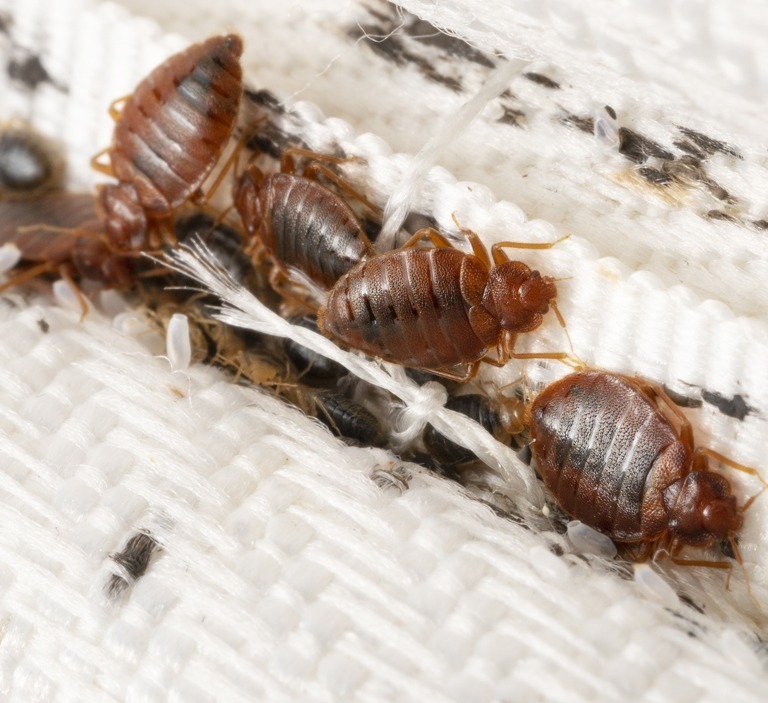Bed bugs spread from house to house through infested items like furniture and luggage. They can also move between units in multi-dwelling buildings.
This makes it essential to take precautions when traveling or acquiring used furniture to prevent the spread of these pests. These parasitic insects are adept at hitchhiking, and their small size and ability to hide in tiny crevices make them difficult to detect and eradicate.
While they do not fly or jump, bed bugs can crawl from one location to another, causing infestations to quickly spread if not properly managed. Understanding their modes of transmission can help people take proactive measures to prevent the spread of these pests and effectively eliminate infestations.

Credit: www.terminix.com
Modes Of Transmission
Bed bugs are notorious hitchhikers, easily spreading from one place to another. Understanding the modes of transmission is crucial in preventing their relentless invasion. Here are the primary ways by which these pesky pests can travel from house to house:
Traveling On Infested Items
Bed bugs have a knack for hitching rides on infested items. They can lurk in used furniture, luggage, electronics, and other household items, waiting for an opportunity to infest a new home. This mode of transmission makes it imperative to exercise caution when bringing second-hand items into your living space.
Hitchhiking On Clothes And Belongings
These tiny bloodsuckers can easily cling to clothes and belongings, using unsuspecting individuals as their unwitting chauffeurs. Whether it’s a backpack, purse, or even a coat, bed bugs seize any chance to relocate to a new environment. This method of transmission highlights the importance of vigilance, especially after visiting places where bed bug infestations are a concern.
Factors Aiding Spread
Bed bugs are notorious for their ability to spread from one house to another, causing distress and discomfort for homeowners. Several factors contribute to the spread of these pests. Understanding these factors is crucial in implementing effective prevention strategies.
Increased Travel And Tourism
The rise in global travel and tourism has significantly contributed to the spread of bed bugs. These pests are adept at hitching a ride on luggage, clothing, and other personal belongings, allowing them to easily move from hotels, hostels, and other accommodations to people’s homes.
Lack Of Awareness And Prevention Measures
Many people are unaware of the signs of bed bug infestations and the measures needed to prevent their spread. This lack of awareness leads to delayed detection and inadequate prevention efforts, facilitating the movement of bed bugs from house to house.
Social Settings And Spread
Understanding how bed bugs spread in social settings is crucial to preventing infestations from moving between houses.
Shared Living Spaces
Shared living spaces such as dormitories or shelters can serve as hotspots for bed bug infestations due to frequent turnover of residents.
Affect On Multi-unit Housing
In multi-unit housing, bed bugs can easily move between adjoining units through walls, floors, and shared plumbing.

Credit: emoyer.com
Detection Challenges
Bed bugs can spread from house to house through infested furniture, clothing, or luggage. Detecting these pests can be challenging as they hide in cracks and crevices. Visual inspections for signs of bed bugs such as blood stains and fecal spots, along with the use of bed bug traps, can help in early detection.
Small Size And Hiding Spots
Bed bugs are experts at hide-and-seek, thanks to their small size and elusive hiding spots. These pests measure just 5-7 millimeters in length, making them extremely difficult to spot with the naked eye. Their flat bodies allow them to squeeze into crevices as thin as a credit card, further exacerbating the challenge of detection. Simply put, bed bugs can hide virtually anywhere in your home, from cracks and crevices in walls and furniture to seams and folds of mattresses, curtains, and upholstery.Resilience To Diy Eradication Attempts
When faced with a bed bug infestation, many homeowners rely on do-it-yourself (DIY) eradication methods. Unfortunately, bed bugs are resilient creatures that have adapted over time to withstand many chemical treatments. This resilience is due in part to their ability to develop resistance to commonly used pesticides. DIY bed bug extermination attempts often fall short, allowing these pesky insects to survive and continue spreading from house to house. Inadequate treatment methods can also lead to a false sense of security, as bed bugs may temporarily disappear only to reemerge later with increased numbers and resilience.To effectively eradicate bed bugs, professional pest control services are often required. These experts utilize comprehensive strategies that target both the adult bed bugs and their eggs, ensuring full eradication of the infestation.In conclusion, the small size and elusive hiding spots of bed bugs make them difficult to detect. Additionally, their resilience to DIY eradication attempts increases the need for professional pest control services. By understanding these challenges, homeowners can take proactive measures to prevent the spread of bed bugs from house to house.Preventive Measures
Preventing the spread of bed bugs from house to house is crucial to maintain a clean and healthy living environment. By following a few simple preventive measures, you can significantly reduce the risk of an infestation. Incorporating regular inspection routines and establishing cleaning and decluttering practices are key components of an effective prevention strategy.
Regular Inspection Routines
Regularly inspecting your home for signs of bed bug activity is essential in identifying any potential problems early on. By implementing inspection routines, you can detect bed bugs before they have a chance to spread from house to house.
Consider the following tips for effective inspections:
- Check your mattress and box springs for any signs of bed bug infestation, such as dark spots or tiny eggs.
- Inspect furniture, including chairs, couches, and dressers, as bed bugs can easily hide in crevices and upholstery.
- Examine baseboards, electrical outlets, and cracks in walls, as bed bugs can hide in these areas.
- Look for blood stains or dark spots on bedding, indicating the presence of bed bugs.
Cleaning And Decluttering Practices
Maintaining a clean and clutter-free living space is vital in preventing the spread of bed bugs. Bed bugs are attracted to cluttered areas as they provide numerous hiding spots, making it easier for them to move from one house to another undetected.
Follow these cleaning and decluttering practices:
- Regularly vacuum your home, paying special attention to carpets, rugs, and upholstery.
- Wash and dry your bedding, linens, and clothing regularly at high temperatures to eliminate any potential bed bug infestations.
- Store clothing and other items in sealed plastic bags or containers to prevent bed bugs from infesting them.
- Reduce clutter in your home by getting rid of unnecessary items. This will minimize potential hiding spots for bed bugs.
By incorporating regular inspection routines and implementing proper cleaning and decluttering practices, you can significantly reduce the risk of bed bugs spreading from house to house. These preventive measures play a crucial role in maintaining a bed bug-free living environment and ensuring your peace of mind.

Credit: www.purcorpest.com
Professional Intervention
When bed bugs become too challenging to handle on your own, it’s time to consider Professional Intervention. Professionals have the expertise to effectively eradicate bed bugs and prevent spread to neighboring homes.
When To Seek Professional Help
Upon noticing persistent bed bug infestations despite DIY efforts, contact a professional immediately. Prompt action is crucial to prevent further spread.
Treatment Options And Control Strategies
- Heat treatments are effective in killing bed bugs at all life stages.
- Chemical treatments, when used by professionals, can efficiently eliminate infestations.
- Vacuuming and steam treatments are also common strategies to combat bed bugs.
Frequently Asked Questions For How Do Bed Bugs Spread From House To House?
How Do Bed Bugs Spread From House To House?
Bed bugs can spread from house to house through various means. They can hitch a ride on clothing, furniture, luggage, or even through wall cracks and electrical outlets. They are excellent climbers and can travel long distances in search of new feeding grounds.
It is important to take preventative measures and seek professional help if infested to prevent further spread.
Can Bed Bugs Move Through Walls?
Bed bugs have the ability to move through walls and other small openings. They can squeeze through tiny cracks and crevices, making it easier for them to infest neighboring rooms or units. It is crucial to inspect and treat all areas adjacent to an infested space to effectively eliminate bed bug populations.
How Long Can Bed Bugs Survive Without Feeding?
Bed bugs can survive for several months without feeding. They enter a state of hibernation called diapause, where their metabolism slows down and they can go without blood meals. However, they will become active and seek out a host when they sense carbon dioxide and body heat.
Regular feeding is necessary for their reproduction and survival.
Conclusion
Understanding how bed bugs spread is crucial for prevention. By being aware of their transportation methods, you can safeguard your home. Regular inspection and early intervention are key to controlling infestations. Keep your living spaces clean and clutter-free to minimize the risk of bed bug transmission.
Stay informed and proactive to protect your home.
Related posts:

I’m MD Tanvir, and I bring years of expertise gained from working closely with pest control companies to the forefront. My journey in the industry has inspired me to launch Bug Battler, a platform aimed at equipping people with the know-how to combat pests autonomously. Through Bug Battler, I aim to empower individuals with practical insights to tackle pest infestations effectively.

